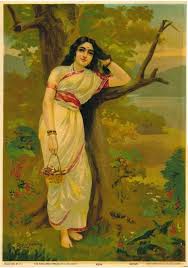AHALYA On seeing Ahalya, the wife of sage Gautama, Indra, the king of gods was fascinated. He repented in his mind, when he got a thousand marks of vulva on his body.(Prabhati M. l, pp 1343-44) The god Indra wailed and wept, when he received a thousand marks of vulva on his body.(Var Ramkali M. 3, Shalok M. l, p. 953) The wife of Gautama, who had been turned into a stone, was saved. (Gond Namdev, p. 874) Gautama, the sage, was the Guru of Indra, the king of gods. He had a very pretty wife named Ahalya. On seeing her enchanting beauty, Indra was highly fascinated.While the sage was out for taking a bath, Indra entered the hermitage in the guise of the sage and took bed with Ahalya.
Indra was not left the place still, when the sage returned. Indra and Ahalya were both cursed by the sage. Indra had to lose his testicles and his body was tainted with a thousand marks of vulva on his body. Ahalya was to be turned into a stone. On her entreaties, the sage took pity on her and declared that she would take her original form, the moment Sri Rama touched her in Treta Yuga. It is said in the Ramayana, that Sri Rama, while wandering in the forests of Dandaka, touched Ahalya with his feet and restored her to her former state.
References :
1. Kohli, Surindar Singh, Dictionary of Mythological References in Guru Granth Sahib, 1993
Ahalya, a character from Hindu epics, was the wife of Sage Gautama and is often remembered for her fall from grace due to a deceitful act by Lord Indra. As a result, Ahalya was cursed to turn into stone, awaiting liberation through divine intervention. In the Ramayana, her redemption came when Lord Rama’s touch restored her to life, symbolizing the transformative power of divinity and forgiveness.
In the Guru Granth Sahib, mythological references like Ahalya’s story are reinterpreted to emphasize spiritual awakening and the boundless grace of the Creator. Ahalya’s plight and eventual redemption symbolize the victory of divine compassion over human frailty, offering hope to those burdened by their mistakes. Her story serves as a metaphor for breaking free from the cycles of ignorance and sin through devotion and surrender to the divine.
The hymns of the Guru Granth Sahib do not dwell on historical or mythological details but focus on the underlying spiritual essence. Through the reference to Ahalya, the scripture highlights the importance of divine grace and the transformative potential of meditative remembrance (Simran) and righteous living. It teaches that the Creator’s love is all-encompassing, capable of restoring even the most lost souls to their spiritual path.
In conclusion, the mention of Ahalya in the Guru Granth Sahib transcends its mythological origins to deliver universal lessons of humility, forgiveness, and divine grace. It inspires individuals to rise above their past mistakes and embrace the journey toward spiritual enlightenment, guided by the Creator’s ever-present compassion.







